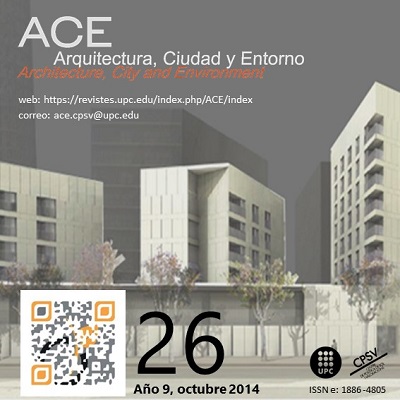Dinàmiques en l'entorn construït: renovació, gentrificació i turisme. El cas de la Barceloneta
DOI:
https://doi.org/10.5821/ace.9.26.3688Paraules clau:
Espai construït, renovació urbana, gentrificació, turisme, La Barceloneta.Resum
Els centres històrics han estat històricament objecte de polítiques d'intervenció a la cerca de la seva regeneració física, econòmica i social. L'alta vulnerabilitat d'aquests espais es posa de manifest al contraposar-se forces de diferent ordre que evidencien el potencial conflicte d'ús entre els diferents agents que ‘consumeixen’ el territori. Així, als efectes de curt termini producte de les millores immediates ocasionades per la regeneració als residents habituals, s'han de sumar les conseqüències de major abast generades al barri per l'arribada de nous residents o gentrifiers, atrets tant per l'atmosfera del barri com pels resultats de la regeneració. Els centres històrics representen a més enclavaments de màxim interès per quis visita la ciutat, tant sigui per períodes curts de vacances com per temporades més llargues. En síntesi, en aquests barris conflueixen usos molt diferents i fins i tot excloents de l'espai: a la funció residencial se li contraposa l'activitat turística i el conjunt de sectors econòmics associats a la mateixa.
L'article examina les conseqüències dels canvis residencials al barri de la Barceloneta de Barcelona fent una èmfasi particular fent particular recalcament a l'evolució del mercat de l'habitatge. S'examinen els riscos potencials de la complexa convivència de diferents usos de l'espai assenyalant davant la creixent vulnerabilitat del barri, la necessitat de protegir l'entorn per garantir el dret a la ciutat i a l'habitatge digne.
Descàrregues
Publicades
Número
Secció
Llicència
| CRITERIS DE PROTECCIÓ INTEL·LECTUAL |
En aquest moment es compta amb la protecció de la Oficina Espanyola de Patents i Marques, mentre que la protecció global s'està tramitant davant la Organització Mundial de la Propietat Intel·lectual (OMPI/WIPO). Així mateix, la Oficina del Número de Sèrie Estàndar Internacional (ISSN) ha otorgat els següents números: 1886-4805 (versió electrònica) i 1887-7052 (versió en paper). |
| COPYRIGHT |
El contingut dels articles i els comentaris en ells expresats són responsabilitat exclusiva dels seus actors, i no reflexen necessariament la opinió del Comité Editor de la revista. Els treballs publicats per ACE queden sotmesos a la llicència CC BY-NC-ND 3.0 ES http://creativecommons.org/licenses/by-nc-nd/3.0/es/ La qual cosa vol dir que les persones autores només tenen i retenen els drets d'autor dintre de les limitacions imposades per la anterior llicència |





































